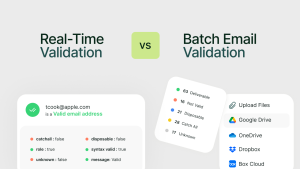Every marketer faces the same question — how much does email validation really cost?
Pricing models for email validation APIs vary by how you use them: some charge per verification, others offer monthly credits, and a few include hidden or indirect costs that affect your long-term ROI.
Understanding these pricing models helps marketers align their email list cleaning frequency, validation accuracy, and budget efficiency — all core parts of your strategy for achieving email deliverability success.
What Drives Email Validation Pricing
- Per-check cost: Many providers charge one price per email validated. For example, some plans highlight $0.008 per verification for large volumes.
- Subscription / monthly plans: Some services bundle a number of validations in a monthly fee or offer credits.
- Hidden / extra costs: These can include extra fees for deep-level checks (SMTP), bulk-list uploads, or failing to utilise “free tier” credits.
- Volume discounts: Larger lists often reduce cost per check (e.g., $0.008 → $0.0045 per verification as volume increases).
- Real-time vs batch differences: Real-time validations (on sign-up forms) may incur slightly higher cost per check than bulk list validations due to latency, API performance requirements, and instantaneous response expectations.
Why It Matters
Poor email list validation wastes budget. In fact, your earlier blog “Why 62% of Your Marketing Budget is Lost to Invalid Emails…” shows how invalid addresses drain campaigns.
Selecting the wrong pricing model or under-estimating validation cost can:
- Raise the cost per valid lead
- Lower deliverability because of neglected list cleaning
- Increase indirect costs like CRM storage, bounce handling, and campaign failures
Therefore, aligning your validation strategy with cost structure ensures better ROI and cost-effectiveness.
Pricing Models for Email Validation APIs: Cost per Check, Subscriptions, and Hidden Costs
1. Cost per Check – Pay for What You Use
Businesses pay per email validation they perform.
In a pay-as-you-go model, every API call equals one check — perfect for startups or teams validating smaller lists.
- Usually priced between $0.001 to $0.01 per email, depending on volume.
- Best for real-time integrations on forms, landing pages, or CRM entries.
- No commitment — but can become costly if validation volume grows.
Example:
A CRM platform that validates 50,000 new leads monthly might spend less using batch subscriptions than per-check billing.
Read next: Real-Time Email Verification: How to Validate Email Addresses Instantly in 2025
2. Subscription-Based Plans – Predictable Cost, Better Scalability
Subscription models bundle a set number of validations into one flat fee.
- Ideal for marketing teams with consistent campaigns or agencies managing multiple clients.
- Offers discounted cost per check as validation volume increases.
- Enables budget predictability and easier integration with CRM systems and marketing platforms.
Many premium providers also offer tiered plans — where pricing decreases as usage increases, giving flexibility for scaling campaigns.
Related post: Compare your validation options in Real-Time vs Batch Email Validation: When to Use Each
3. Hidden Costs – The Charges You Don’t See
Email validation providers may include hidden or indirect costs that impact ROI.
While per-check and subscription plans are transparent, marketers often overlook:
- Overage fees when exceeding monthly credits.
- Add-on charges for deep validation (catch-all detection, SMTP-level checks).
- API latency and throughput limits that can slow integrations.
- Low-accuracy results that indirectly raise campaign costs through high bounce rates.
Choosing a cheaper API with 90% accuracy can cost more over time than a premium provider with 99% accuracy — because poor data quality damages sender reputation and email deliverability.
Dive deeper into benchmarks and performance in Email Validation Accuracy: Metrics, Benchmarks & How Providers Compare
4. How Pricing Impacts Your Email Strategy
Validation model influences your data hygiene, cost efficiency, and deliverability rate.
- Real-time APIs cost more per check but prevent invalid sign-ups immediately.
- Batch validation is cheaper for periodic list cleaning.
- Hybrid approaches combine both for maximum accuracy and cost balance.
When connected to your CRM or automation workflows, a scalable pricing model ensures you maintain accuracy without overspending — key for long-term ROI and compliance with email regulations.
5. Choosing the Right Model for Your Business
Marketers should evaluate total cost versus validation accuracy and campaign scale.
| Business Type | Best Model | Why |
|---|---|---|
| Startups / SMBs | Cost per check | Pay only for active validation needs |
| Mid-level Agencies | Subscription | Balanced pricing + predictable cost |
| Enterprise / SaaS | Hybrid | Integrates real-time + bulk at scale |
For step-by-step implementation, refer to the Complete Guide on Email Validation API
Read More : Complete Guide on how to integrate an email valifation API
Sample Pricing Models Of Top Email Validation Tools
1. Gamalogic Email Validation Api
- Free plan available; entry-level option uses “1,000 free credits on registration”.
- A quoted list: $15 for 5,000 emails; $120 for 100 K emails; $960 for 1 M emails (via third-party comparison).
- Best suited for developers integrating into signup forms + bulk list workflows.
2. ZeroBounce
- Pay-as-you-go: credits from ~2,000 verifications for ~$18 (≈$0.009 per email).
- Subscription plans: for example, “ONE™” plan gives 25,000 email verification credits for ~$99/month.
- Strong choice for marketers who want full service and high volume.
3. NeverBounce
- Entry pay-as-you-go: ~$8 for 1,000 credits (≈$0.008 per email).
- Monthly plan: ~$29/month for 10,000 validations (≈$0.0029 each) in some tiers.
- Good for mid-volume cleaning and API users.
4. Clearout
- Freemium + pay-as-you-go: e.g., “$21 for 3,000 credits” start.
- Transparent subscription or annual plans; multiple credit bundles.
- Flexible for smaller teams or growing lists.
5. Bouncer
- Pay-as-you-go: start ~$8 for 1,000 verifications.
- Large-volume discounts: e.g., $0.004 per email at 100k+ volumes.
- Useful when you need large batch cleaning with minimal cost per check.
How to Use These Models
- Compare cost per check (i.e., cost per email verified) across providers.
- Choose the model that aligns with your volume, validation frequency, and accuracy needs.
- Beware of hidden costs: overage fees, deep-check surcharges, or low accuracy that indirectly costs you more (bounces, reputation).
- Connect to your workflows: real-time validation for signup forms + batch validation for lists = balanced approach.
Conclusion
Understanding the pricing models for email validation APIs means more than comparing numbers — it’s about evaluating accuracy, scalability, and long-term ROI.
The smartest marketers don’t just pick the cheapest API; they choose the one that balances cost, accuracy, and consistency across real-time and batch validation.
💡 Want to see how pricing affects campaign performance? Explore Why 62% of Your Marketing Budget is Lost to Invalid Emails and ensure your validation model supports your marketing goals.
You might also like

Real-Time vs Batch Email Validation: When to Use Each
Real-Time vs Batch Email Validation: When to Use Each? In this guide, we’ll break down the difference between real-time and batch (bulk) email validation

Master Email Deliverability with Proper Email Authentication
Master email deliverability by implementing proper email authentication protocols like SPF, DKIM, and DMARC. These tools not only protect your domain but also ensure your emails reach inboxes—safely and reliably.

Real-Time Email Verification: How to Validate Email Addresses Instantly in 2025
In 2025, precision in email communication is no longer optional—it's essential. This blog explores the power of real-time email verification and how it enables instant validation of email addresses before they reach your list. Discover the latest tools, techniques, and benefits that help ensure your messages land in real inboxes—protecting deliverability, improving engagement, and maintaining sender reputation.






 No credit card required
No credit card required


Post your Comment.